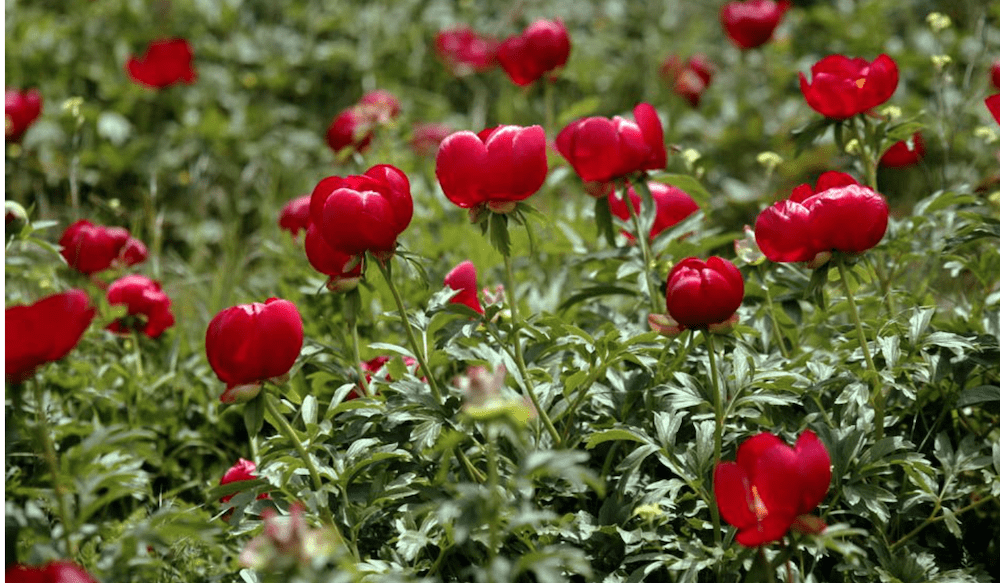
July: Romania's National Flower the Peony
|
|
|||||||||||||
Romania and the Peony
Romania is home to five indigenous species of peony that are growing in the wild in Romanian forests and fields, from the Black Sea coast, in Dobrogea, to Banat, in Oltenia, southern Moldavia, Ardeal and even Bihor county. Beautiful red blossoms usually bloom in the later half of May and grow in the hundreds in national peony reserves across the country. Add a peony preserve to the list of places I want to visit in my lifetime!
Peonies have been intertwined with Romanian culture throughout history whether it be in traditions, adornment, or medicine. There’s an old custom where peony petals would be added to the water where newborns bathed to help make them stronger and protect them from evil. A custom similar to that of the Bulgarians and Turkish people.
Medicine
Romania is not alone in using peonies as medicine. China has been developing medicines from peony roots since 220 A.D. and an interesting study came out more recently on the clinical effects of peonies. The medicines have the functions of clearing heat, cooling blood, promoting blood circulation, and removing blood stasis. They’ve also been described as analgesic, sedative, anti-inflammatory, immunomodulatory, antioxidant, and antimicrobial properties
White peony has been shown to positively influence low progesterone, modulate estrogen and prolactin (all very important hormones) and reduce elevated testosterone levels. There’s even new research coming out on using Paeoniflorin, the medicinal compound found in peonies, against Parkinson’s disease.

Some peony species involved in the Chinese Medicine study (source 2 if you’re interested)
Ecology and Cultivation
 The peony is part of the Paeoniaceae family, which exclusively contains peonies. Because of its high ecological adaptability, the peony can be grown almost anywhere in Romania, from the plains to the mountains.
The peony is part of the Paeoniaceae family, which exclusively contains peonies. Because of its high ecological adaptability, the peony can be grown almost anywhere in Romania, from the plains to the mountains.
Peonies are generally grown from tubers and often need a few years to establish. Unlike many perennials, they thrive on mild neglect, according to the Farmer’s Almanac. They grow in a range of hardiness zones from 3-8 and enjoy full sun to grow their astounding blooms.
You may have heard of the old story that ants help peonies bloom. As much as I’d love to believe that, it’s not true. The ants don’t help the flower open, but they do have a great mutualistic relationship. Peonies have extrafloral nectaries, which are organs that secrete nectar outside of the flower bud. The ants feed on the nectar as the flower is coming into bloom, and in return they protect the flower from other insects. Once the flowers bloom, the ants go find a new food source.
Fun Facts
There are more than 100,000 people with the name “Peony” in Romania, though it translates to Bujor. They even have expressions that translate to “red as a peony” or “going peony in the face”.
Peonies love cold winters and will even thrive as far north as Alaska.
Partially cooked and sweetened petals of peony flowers are served as desserts in different countries as a delicacy.
---------------------
Thank you for joining to learn about peonies!
Curious to learn more? Checkout these sources!
https://www.rri.ro/en/features-and-reports/inside-romania/the-romanian-peony-id137237.html#:~:text=There's%20also%20an%20old%20custom,national%20flower%2C%20like%20other%20countries.
https://www.nature.com/articles/s41598-019-54863-y
https://www.sciencedirect.com/topics/biochemistry-genetics-and-molecular-biology/paeoniflorin#:~:text=White%20Peony,-White%20peony%20is&text=Paeonia%20has%20been%20shown%20to,action%20on%20the%20aromatase%20enzyme.
https://valahia.news/peony-national-flower-and-floral-symbol-of-romania/
https://www.almanac.com/plant/peonies
